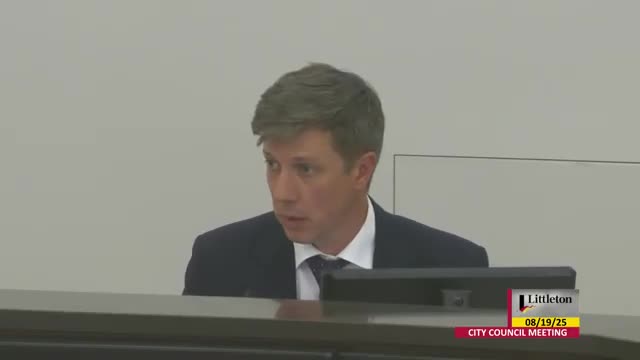Littleton City Council Approves Master Sign Plan Amid Public Concerns
August 20, 2025 | Littleton City, Arapahoe County, Colorado
This article was created by AI summarizing key points discussed. AI makes mistakes, so for full details and context, please refer to the video of the full meeting. Please report any errors so we can fix them. Report an error »

The Littleton City Council held a regular meeting on August 19, 2025, where they discussed significant amendments to the city’s master sign plan and entered an executive session to evaluate the performance of key city officials.
During the meeting, the council reviewed proposed changes to the Unified Land Use Code (ULUC) regarding signage. The discussion highlighted the potential for commercial properties to collaborate on sign applications, promoting uniformity and aesthetic improvements in the city. However, public feedback revealed concerns about the clarity of the proposed changes. Pam Chadbourne, a local resident, expressed her confusion over the sign options presented and emphasized the need for visual scenarios to help the community understand the implications of the new regulations. She argued that the character of Littleton, shaped over decades, could be jeopardized by poorly designed signage that prioritizes business interests over community aesthetics.
Chadbourne urged the council to maintain strict regulations on sign sizes and placements, particularly regarding monument signs and their relationship to surrounding buildings. Her comments resonated with some council members, who acknowledged the importance of balancing business needs with the city’s character.
Despite these concerns, the council moved forward with a motion to approve the amendments to the master sign plan, which passed unanimously with a vote of 7-0. Council members noted the importance of supporting local businesses while ensuring that signage does not detract from the community's visual appeal.
Following the public discussion, the council entered an executive session to evaluate the performance of the city manager and city attorney, a standard procedure that allows for confidential discussions regarding personnel matters. No formal actions were taken during this session, and the council concluded the meeting without further business.
The decisions made during this meeting reflect ongoing efforts by the Littleton City Council to navigate the complexities of urban development while considering community feedback and maintaining the city’s unique character.
During the meeting, the council reviewed proposed changes to the Unified Land Use Code (ULUC) regarding signage. The discussion highlighted the potential for commercial properties to collaborate on sign applications, promoting uniformity and aesthetic improvements in the city. However, public feedback revealed concerns about the clarity of the proposed changes. Pam Chadbourne, a local resident, expressed her confusion over the sign options presented and emphasized the need for visual scenarios to help the community understand the implications of the new regulations. She argued that the character of Littleton, shaped over decades, could be jeopardized by poorly designed signage that prioritizes business interests over community aesthetics.
Chadbourne urged the council to maintain strict regulations on sign sizes and placements, particularly regarding monument signs and their relationship to surrounding buildings. Her comments resonated with some council members, who acknowledged the importance of balancing business needs with the city’s character.
Despite these concerns, the council moved forward with a motion to approve the amendments to the master sign plan, which passed unanimously with a vote of 7-0. Council members noted the importance of supporting local businesses while ensuring that signage does not detract from the community's visual appeal.
Following the public discussion, the council entered an executive session to evaluate the performance of the city manager and city attorney, a standard procedure that allows for confidential discussions regarding personnel matters. No formal actions were taken during this session, and the council concluded the meeting without further business.
The decisions made during this meeting reflect ongoing efforts by the Littleton City Council to navigate the complexities of urban development while considering community feedback and maintaining the city’s unique character.
View full meeting
This article is based on a recent meeting—watch the full video and explore the complete transcript for deeper insights into the discussion.
View full meeting
